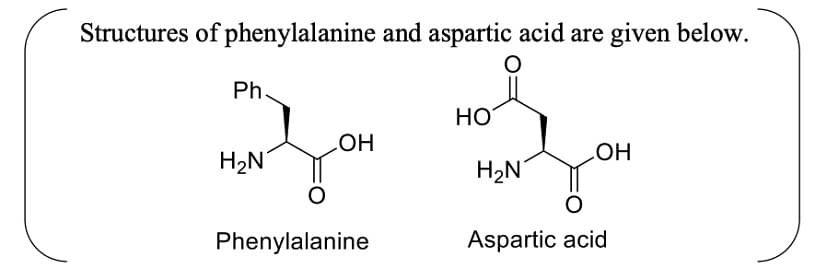Question:
Nucleotides are building blocks of nucleic acids. Each nucleotide is a composite molecule formed by
Nucleotides are building blocks of nucleic acids. Each nucleotide is a composite molecule formed by
Updated On: Apr 20, 2024
- Base-sugar-phosphate
- Base-sUgar-OH
- (Base-sugar-phosphate)n
- Sugar-phosphate
Hide Solution
Verified By Collegedunia
The Correct Option is A
Solution and Explanation
Each nucleotide consists of three distinct units - a phosphate group derived from phosphoric acid, a pentose sugar and a ring shaped nitrogenous base. The base-sugar combination without phosphate group is called nucleoside. A nucleotide is formed by the reaction of sugar portion of a nucleoside with phosphoric acid through dehydration synthesis, e.g. Adenosine monophosphate - composed of ribose, adenine and phosphate.
Was this answer helpful?
0
0
Top Questions on Biomolecules
- Match List-I with List-II:

- CUET (UG) - 2024
- Chemistry
- Biomolecules
- For a double strand DNA, one strand is given below:

The amount of energy required to split the double strand DNA into two single strands is _____ kcal mol−1.
[Given: Average energy per H-bond for A-T base pair = 1.0 kcal mol−1, G-C base pair = 1.5 kcal mol−1, and A-U base pair = 1.25 kcal mol−1. Ignore electrostatic repulsion between the phosphate groups.]- JEE Advanced - 2024
- Chemistry
- Biomolecules
- Aspartame, an artificial sweetener, is a dipeptide aspartyl phenylalanine methyl ester. The structure of aspartame is

- JEE Advanced - 2024
- Chemistry
- Biomolecules
Given below are two statements:
Statement I: A unit formed by the attachment of a base to 1' position of sugar is known as nucleoside.Statement II: When nucleoside is linked to phosphorous acid at 5 -position of sugar moiety, we get neucleotide.In the light of the above statements, choose the correct answer from the options given below:- NEET (UG) - 2023
- Chemistry
- Biomolecules
- How many of the following- amino acids contain sulphur?
Lysine; Methionine; Glutamic acid; Threonine
Arginine; Cysteine; Tyrosine; Isoleucine- JEE Main - 2023
- Chemistry
- Biomolecules
View More Questions
Questions Asked in NEET exam
- In a Vernier caliper, \(N+1\) divisions of vernier scale coincide with \(N\) divisions of main scale. If 1 MSD represents 0.1 mm, the vernier constant (in cm) is:
- NEET (UG) - 2024
- Units, Dimensions and Measurements
- A tightly wound \(100\) turns coil of radius \(10 cm\) carries a current of \( 7 A\). The magnitude of the magnetic field at the centre of the coil is (Take permeability of free space as \(4\pi×10^{-7}\) SI units):
- NEET (UG) - 2024
- Magnetic Field
- Consider the following statements A and B and identify the correct answer:

A. For a solar-cell, the I-V characteristics lies in the IV quadrant of the given graph.
B. In a reverse biased pn junction diode, the current measured in (µA), is due to majority charge carriers.- NEET (UG) - 2024
- P-N Junction
- Given below are two statements :
Statement I : In the nephron, the descending limb of loop of Henle is impermeable to water and permeable to electrolytes.
Statement II : The proximal convoluted tubule is lined by simple columnar brush border epithelium and increases the surface area for reabsorption.
In the light of the above statements, choose the correct answer from the option given below :- NEET (UG) - 2024
- Nephrons
- The maximum elongation of a steel wire of 1 m length if the elastic limit of steel and its Young’s modulus, respectively, are 8 × 108 N m–2 and 2 × 1011 N m–2, is :
- NEET (UG) - 2024
- Youngs double slit experiment
View More Questions
Concepts Used:
Biomolecules
Biomolecules are the most essential organic molecules, which are involved in the maintenance and metabolic processes of living organisms. These non-living molecules are the actual foot-soldiers of the battle of sustenance of life.
There are four major classes of Biomolecules – Carbohydrates, Proteins, Nucleic acids and Lipids.
- Carbohydrates are chemically defined as polyhydroxy aldehydes or ketones or compounds which produce them on hydrolysis.
- Proteins are another class of indispensable biomolecules, which make up around 50per cent of the cellular dry weight. Proteins are polymers of amino acids arranged in the form of polypeptide chains. The structure of proteins is classified as primary, secondary, tertiary and quaternary in some cases.
- Nucleic acids refer to the genetic material found in the cell that carries all the hereditary information from parents to progeny. There are two types of nucleic acids namely, deoxyribonucleic acid (DNA) and ribonucleic acid (RNA). The main function of nucleic acid is the transfer of genetic information and synthesis of proteins by processes known as translation and transcription.
- Lipids are organic substances that are insoluble in water, soluble in organic solvents, are related to fatty acids and are utilized by the living cell.



